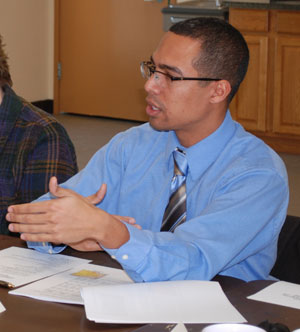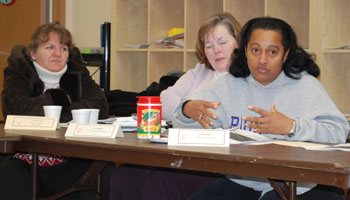Making Bryant Better

No one violated the Bryant Community Center rules at a recent meeting there, though you could argue there was a bit of mild horseplay.
If you made a list of people who can get things done, you’d end up with one that looked a lot like the actual people attending a recent meeting at the Bryant Community Center. Two current city councilmembers and a former one. The county treasurer and chief deputy clerk. A school board member. A cop. Nonprofit leaders, city staff and residents.
They gathered on Thursday to talk about ways to improve this neighborhood on Ann Arbor’s southeast side, north of Ellsworth and east of Stone School Road. The effort is being led by the Community Action Network, a nonprofit group that provides support services to people in low-income neighborhoods. CAN was hired earlier this year to manage Bryant and Northside community centers, and also works with Hikone and Green Baxter Court neighborhoods. Joan Doughty, CAN’s executive director who organized the Dec. 11 meeting, told the group that her staff had done a needs assessment of the neighborhood and found that safety was the biggest concern for residents. She noted that the assessment was done around the time of the multiple break-ins in that area, which might have been a factor. (The police arrested three teens in April who were charged with those crimes.)

Joan Doughty, executive director of the Community Action Network, a nonprofit which manages Bryant Community Center.
The mortgage crisis is another major concern. The neighborhood has been a place where you could find some of the lowest-priced single-family homes in Ann Arbor. Many of these homeowners are in fragile financial circumstances, made worse by current economic conditions.
Catherine McClary, Washtenaw County treasurer, didn’t have specific data for the Bryant neighborhood, but gave an overview of the foreclosure situation countywide. in 2006, 703 properties were foreclosed for non-payment of mortgage (as opposed to non-payment of taxes, another type of foreclosure). Last year, that number rose to 1,151, and so far in 2008, there have been 1,300 mortgage foreclosures.
Tax delinquencies are typically a prelude to foreclosure, McClary said. Those, too, are on the rise – in Ann Arbor, they are up 43% this year compared to 2007. “I do think Ann Arbor’s not immune,” she said. McClary also highlighted some of the resources that are available for preventing both mortgage and tax foreclosures. The county is partnering with other local groups as part of this effort, including the Housing Bureau for Seniors, the Washtenaw County MSU Extension program, and Legal Services of South Central Michigan – all of those groups had representatives at Thursday’s meeting.
Jennifer L. Hall, housing manager for the city/county office of community development, described several programs with federal funding that are available for down payment assistance, rehab of single-family homes and infrastructure improvements, such as sidewalk repair. Since Bryant has a lot of low-income housing, Hall said the city would be focusing on that neighborhood.
Hall also mentioned that the city and county would be forming a land bank, and McClary elaborated on what that would entail. The land bank, which would be managed by the treasurer’s office, would identify condemned, blighted properties – that weren’t owner-occupied, she stressed – and demolish them to prepare for other uses, such as community gardens. When she stated that she didn’t think there was such a property in the Bryant neighborhood, several residents said, “Oh yeah, there’s one.”
At one point, Doughty observed that there seem to be a wealth of resources available, but a bit of a disconnect in getting those resources to the people who need them. She suggested that they compile a list of the resources mentioned during the meeting, and make it available for everyone in the group.

Derrick Jackson, Washtenaw County's chief deputy clerk, talked about the West Willow neighborhood revitalization project, which could be a model for similar efforts in the Bryant area.
Derrick Jackson, Washtenaw County’s chief deputy clerk, was on hand to tell the group about a project he’d been involved with in the West Willow neighborhood of Ypsilanti Township. He said that unlike this meeting, with community stakeholders at the table, the West Willow effort started with residents, including himself. “If you really want to get the word out,” he said, “it’s the neighbors.”
Jackson passed out copies of the West Willow Neighborhood Improvement Strategy, a 33-page document prepared by the consulting firm Hamilton Anderson of Detroit, based on work done by their community group. [5MB .pdf] The report gives an overview of the process used to develop the revitalization plan, a description of the neighborhood demographics, and lists of opportunities for making physical improvements to the area. There’s also an extremely detailed three-year action plan, which sets out steps to be taken by subcommittees on safety, housing/physical improvements, and parks and recreation.
Jackson said that after the neighbors had developed this plan, they then looked for resources to help them achieve their goals.
Judy Gardner, who lives in the Bryant neighborhood, said that getting residents engaged in some kind of community-wide project was a struggle. “That has been a huge barrier,” she said. She asked Jackson for advice, based on his West Willow experience.
Jackson said that West Willow had a couple of “opportunities” – referring to some high-profile crimes there – which motivated people to get involved. He suggested that for Bryant, concerns about foreclosures might serve a similar purpose. He also said that it sometimes takes a couple of people to just take action, then when others see that improvements are being made, they’ll join in.
Hall noted that almost everyone in the neighborhood has a drainage issue, and she suggested that addressing this problem might be a way to get residents involved. Houses were built on a wetland, and driving through the streets on Thursday proved that point – frozen water covered many stretches, making conditions hazardous.
PV Roby of the Homeplace Community Land Trust said that accessing adults through their children might work, too. She said that organizing outreach based by going cul-de-sac by cul-de-sac could be another approach.
Jackson said that one of the things they did at West Willow was to ask kids how they’d spend $20,000 for improving the neighborhood. Even though the question was theoretical, people got excited and started generating all sorts of ideas, he said. The concept resonated with several people at Thursday’s meeting, and some suggested that if the ideas were really good, they might even be able to come up with the $20,000.

Jennifer Hall with the city/county office of community development; Pat Simmons with First United Methodist Church; and Susan Baskett, a school board member and resident of the Bryant neighborhood.
Susan Baskett, a Bryant resident and board member for the Ann Arbor Public Schools, said that one possible first step would be to find someone from each of the neighborhood’s 17 cul-de-sacs and bring them together for a meeting. She said it would be helpful to have the list of Neighborhood Watch block captains from the police department, but they seemed reluctant to release that information. Leigh Greden, one of the two Ward 3 councilmembers who represent that neighborhood, said he could get the list for her.
As the meeting wrapped up, Doughty suggested they divide into two groups to tackle some of these issues: One led by McClary to focus on the foreclosure issue, and another led by Hall that addressed infrastructure. At the same time, they’d work on organizing a meeting of residents to get their input. The meeting adjourned with plans to reconvene in February.






I live just north and west of this area, and it’s nice to see this kind of community. Once they get on their feet, organization wise, I hope that other communities in the area can help out too (if needed).
Is that a 5 million gallon pdf for the West Willow file? ;-)
Good to see that CAN got cooperation (and attendance) from so many government officials and staff.
The photos are great because now we can recognize these folks on the street and thank them for their work. However, when the cursor is placed over them and the file name appears, it might be nice for everyone’s name to be included. (Even better would be if the photos were mapped so that the name changed appropriately as the cursor is moved from one person to another. You can do that, right? Vielmetti will help you figure it out.)
Steve Bean wrote: “Is that a 5 million gallon pdf for the West Willow file? ;-)”
For readers who can’t find the referent of the playful poke that Steve’s making, I fixed the part that used to read “5MG.” Correcting in usual Missed Ticks Chronicle style resulted in a visual mess, unhelpful to anyone, which is why I just changed it.
But without some kind of note, readers will wonder what Steve is talking about.